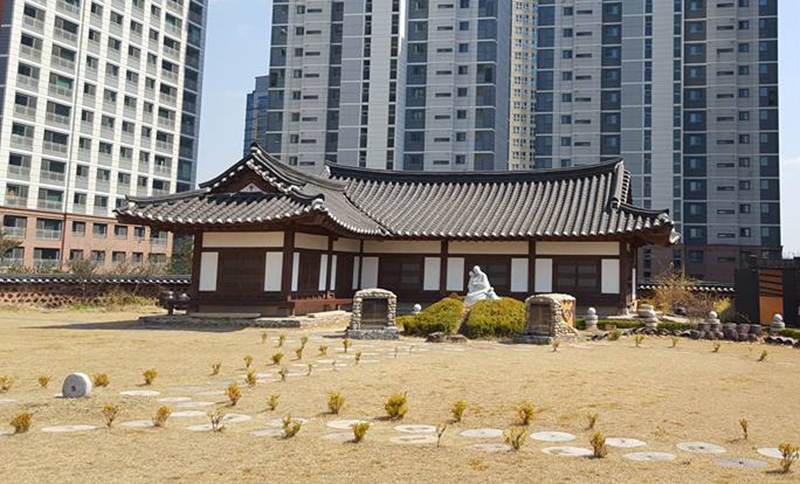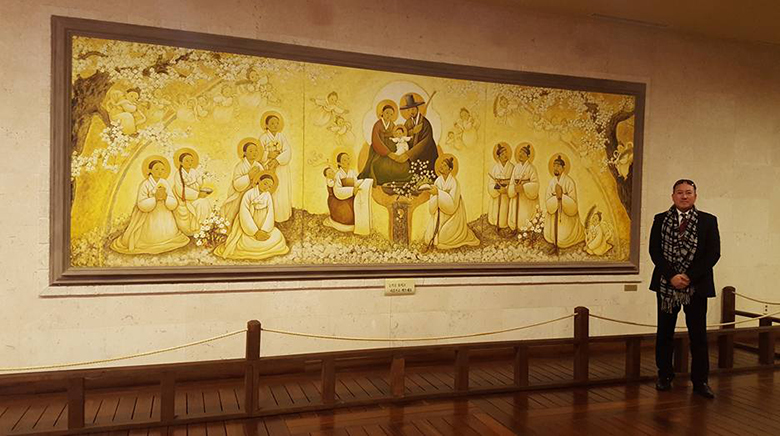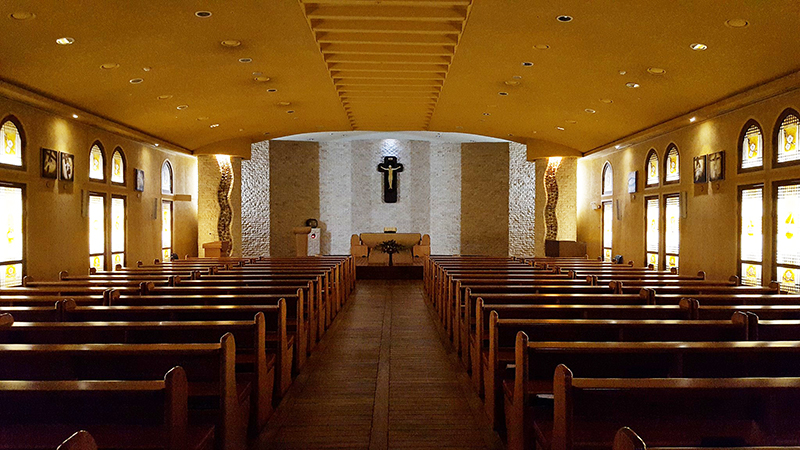View this article in another language
- 한국어
- English
- 日本語
- 中文
- العربية
- Español
- Français
- Deutsch
- Pусский
- Tiếng Việt
- Indonesian

Danggogae Martyrs' Shrine in Seoul's Yongsan-gu District is surrounded by apartment high-rises but remains quiet and serene.
By Korea.net Honorary Reporter Alfonso L. Delgado from the Philippines
Photos = Alfonso L. Delgado
Though Catholics in Korea represent just 11% of the population, their devotion can be felt almost everywhere. I once noticed a Korean woman praying holding the Holy Rosary while riding the subway in Seoul. Her right hand was turning around a bracelet rosary as she prayed. Also, the center of the Roman Catholic Church in Korea, Myeongdong Cathedral, is situated right smack in the middle of Myeongdong, the most famous shopping spot in the country.
But what’s impressive about Catholics in Korea is their encouragement of visits to Catholic pilgrimage sites all over the country. The Korea Tourism Organization even helps by providing online pages and publishes tourist brochures just for these sites, which have their own homepages with information for visitors.
In the middle of Seoul's Yongsan-gu District is a small and quiet hill surrounded by tall apartment high-rises housing Danggogae Martyrs’ Shrine, where ten Korean Catholics were martyred from Dec. 27-28, 1839. Of the ten, nine were made saints while the last one, Blessed Mary Yi Seong-rye, beatified. She was the mother of Thomas Choe Yang-eop, just the second ordained Catholic priest in Korean history. His father, who was executed along with his wife, was made St. Francis Choe Kyong-hwan.
When Yi, 39, was about to be executed, her children asked the executioner that for her "to go to heaven without suffering long, he must cut their mother’s head with a single stroke." The pain, trauma and suffering Yi's children suffered by watching the public execution of their parents must have been unimaginably painful.
At the time of his mother's execution, Choe Yang-eop was in Macao as a student. Due to disturbances in the city-state, he eventually left for Manila. As a Filipino living in Seoul's Yongsan-gu District, I was surprised to learn of the connection of the shrine to the Philippines. Hearing that Korea's second ordained Catholic priest set foot in the Philippines in 1839 to seek refuge and continue his religious studies there was an amazing discovery, as the Philippines, then a Spanish colony, was an emerging Catholic country in the Far East.
In 1861, Choe Yang-eop was back in Korea despite widespread Catholic persecution, but tragically succumbed to typhoid fever the same year at age 40. On his deathbed, he received the Last Sacraments and could barely speak, but managed to utter as his last words the holy names of Jesus and Mary.


Danggogae Martyrs' Shrine honors the sacrifice of Blessed Mary Yi Seong-rye and the birth of Christianity in Korea.
The execution of Korean Catholics not only on this hill but elsewhere on the Korean Peninsula is a testament to the faith of adherents in the country since Christianity arrived here in the early 17th century through Christian literature written in Chinese. And between the late 17th century and 1866, more than 10,000 Korean Catholics, including the ten martyrs, were executed. On May 6, 1984, 103 Korean martyrs were declared saints by Pope John Paul II in the first canonization ceremony held outside the Vatican.
Among those canonized was Saint Andrew Kim Taegon, Korea’s first ordained Catholic priest. Baptized at 15, he also studied in Macao and the Philippines, namely Bocaue, Bulacan, where a church is dedicated to him (yes, a church in the Philippines really is dedicated to a Korean). He was ordained in 1844, but two years later, he was tortured and beheaded near the Han River in Seoul. He was just 25.
Danggogae Martyrs' Shrine commemorates the birth of Christianity in Korea and the devotion and faith of Korean Catholics to God. It continues to inspire all Catholic pilgrims in and out of the country as part of the Catholic pilgrimage scene in Korea. Though surrounded by tall apartment high-rises, the shrine is serene and quiet and houses a chapel and a museum. At the garden above is a Way of the Cross that attracts the faithful during Holy Week. The shrine is also called a mother’s shrine because three of the six women martyred on this spot had young children. Yi was holding a 1-year-old baby when she was captured. She was beatified by Pope Francis in a beatification Mass in Seoul that I attended on Aug. 16, 2014.
How to get to the shrine:
1. Get off Sinyongsan Station (Seoul Subway Line 4) at exit 5.
2. Walk straight until a tunnel appears ahead.
3. Go through the tunnel and after reaching the other side, continue walking until you reach the main street.
4. After reaching the main street, look for the pedestrian lane about 140 meters to the right.
5. Cross the street and turn right after reaching a long, brown building selling appliances and electrical equipment on the other side.
6. The end of the building has a sign pointing to the shrine. Turn left and follow the small street for about 120 meters until you reach the shrine entrance.
7. On the way back, go to the bus stop to take the green minibus #03 on the left side to return to Sinyongsan Station.
wisdom117@korea.kr
*This article is written by a Korea.net Honorary Reporter. Our group of Honorary Reporters are from all around the world, and they share with Korea.net their love and passion for all things Korean.